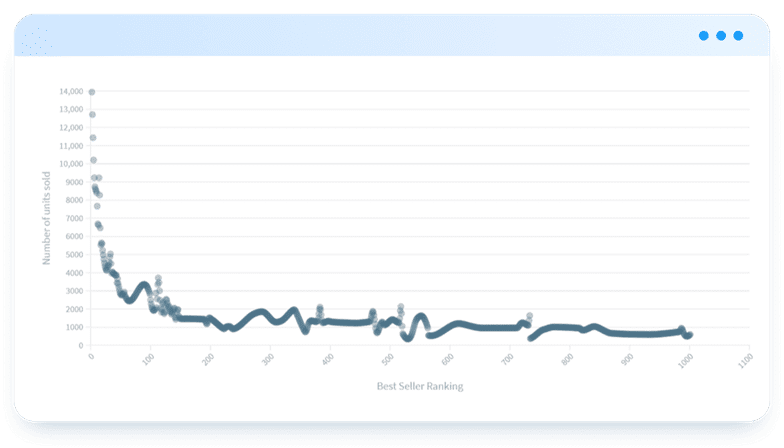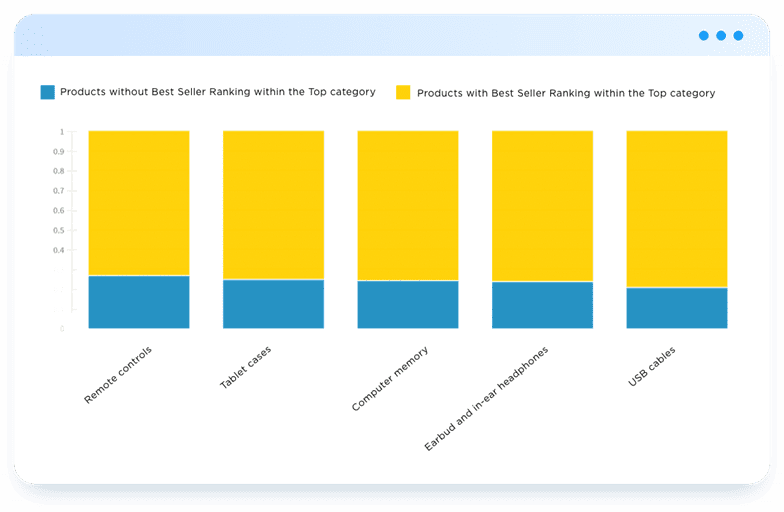How Algopix Approaches Best-Seller Ranking and Sales Estimates
Everything You Need to Know About Best-Seller Ranking
Best-seller ranking. You’ve likely heard about it. It’s that metric Amazon uses to determine a specific product’s popularity within a specific category.
And with over 166 million products listed on Amazon, it’s no wonder why something like the best-seller ranking is essential.
But just how useful is this metric? And can sellers really use it to make accurate sales predictions for the products they want to sell?
What Is the Best-Seller Ranking?
Best-seller ranking refers to the popularity an item has, compared to other items in the same sales category. For example, on Amazon, a lawnmower's ranking is determined based on all other products' rankings in the lawnmower category.
Amazon determines rankings in numerical order based on the number of sales in a specific time period. An item can have multiple rankings if it is present in multiple categories.
Rankings can be determined for millions of products at a time, based on estimated sales metrics for specific time periods like a month, a quarter, or even a year.

Example for Best Seller Ranking and how it appears on Amazon Product page
How Does Amazon's Best-Seller Ranking Calculation Works?
Since Amazon's system is proprietary, it’s not always easy to reverse engineer. Here is what we know about it:
- Big data is involved at every step of the process. Hundreds of millions of data points are addable and analyzable. These data points consist of various metrics like BSR, price, inventory, orders, categories, shipments, etc. Every data point is useful, depending on the algorithm and its requirements.
- All of these data points then need to be sifted through to remove signals from noise. The more data we have, the longer and resource-intensive this process is, but the more accurate it is.
- All these sifted data points influence a product's best-seller ranking. While rankings are only correlative to a product's estimated sales in any given time period, raking is still a good indication of product worth. As such, the more data points you have regarding a specific item, the more qualified that item's ranking will be.

Scatter plot showing Best Seller Ranking and the number of units sold
The more data we have, the longer and resource-intensive this process is, but the more accurate it is.
How Do We Use Best-Seller Ranking in Our Calculation?
Best-seller ranking is one of dozens of components that makes up our product sales estimates. We use the Amazon ranking as information regarding which products are sold on Amazon, which sellers should sell, and the profits and risks associated with a product.
Algopix keeps track of over 50,000+ different ecommerce categories using a unique Algopix taxonomy that supports the taxonomies used by the most common ecommerce marketplaces, such as Amazon, Walmart, Google, eBay, and others.
For every category, Algopix uses dozens of signals to rank the items within a category to produce an Algopix best sellers ranking.
Algopix uses this method to accurately predict the sales volume of all products—the ones we have sales data for and the ones we don’t—based on that ranking mechanism.
Signals include the sales data we receive from 70,000+ brands and sellers, publicly available data such as product price, reviews and catalog rankings, and intention signals—such as search volume signals and more.
Algopix uses this method to accurately predict the sales volume of all products—the ones we have sales data for and the ones we don’t—based on that ranking mechanism.
What about products we don’t have sales data for? We’ll run the sales analysis for similar items within the category or similar rankings in other related categories to gain an accurate estimation of the sales volume for that product.
In order to distinguish 1P and 3P sales, Algopix tracks the seller of record as well as the “Buy Box” owner at any given time.
This lets Algopix know what percentage of sales is contributed by 1P and 3P sellers. If a product is only being offered by 1P sellers, and Algopix is not receiving sales data from this seller, we’ll use the ranking mechanism mentioned above to accurately estimate the sales volume for that item and attribute it to the 1P seller that’s responsible for selling this product.
By doing that, Algopix is the only cross-channel market share and sales data platform that reports 1P + 3P sales data.
Here’s a brief breakdown of the process we use:
- The Algopix engine's insights process starts with a product of interest. To start this process, you need to provide a product identifier, a code required to identify the product in Amazon's system. The product identifier can be a UPC, EAN, or ASIN.
- Data is aggregated and connected. Our engine aggregates all relevant data points connected to your product identifier to generate meaningful insights.
- Our proprietary algorithms analyze the aggregated data. The engine then determines which products are recommended or not to ensure that sellers using our services can quickly make data-enriched decisions.
- We generate insightful predictions. Online sellers now have all the data they need to determine which products to buy and sell their current inventory for the most significant profit-risk ratio.
Amazon provides us with a convenient means to determine an item's popularity and how those items compare with all other items in their sales category.
You might be wondering: why is best-seller ranking for products that are highly ranked within a category more accurate?
Good question. We’ll cover that in the next section.
Why Don't We Use Best-Seller Ranking When an Item Has Insufficient Data?
The more data we have regarding an item, the more accurate the item's ranking will be. But with new categories and subcategories being created all the time, BSR isn’t always enough on its own.
If an item does not have a high BSR ranking, we cannot rely on the data available. Low BSR rankings mean that either the ranking is inaccurate or data is missing.
Missing data can skew rankings wildly, especially if algorithms can make inferences about the missing data. The system is not perfect, but it works.
The following are statistics we compiled from our research, which will help you understand how crucial high best-seller ranking is.
No best-seller ranking is attached to less than five percent of all products tracked. This statistic is low, but not insignificant. Simply put—that is at most, 1 in 20 products.

Example for a product without Best Seller Ranking within the Top category

Distribution of the existence of Best Seller Ranking within the Top Category level, segmented by categories
Just like with search engine optimization, long-term high rankings take time and effort to accumulate.
The most affected categories for low or no best-seller rankings are electronics, including:
- Remote controls
- Computer memory
- USB cables
- Tablet cases
- Earbud and in-ear headphones
Newer products may also not have high best-seller rankings because they are new to the online marketplace. Just like with search engine optimization, long-term high rankings take time and effort to accumulate.
While some products can become very popular quickly, for example, if a celebrity endorses the product or if the product exists in offline markets, not all products have these advantages.
Not including low-ranking data or missing values is commonplace for many statistical studies or research methods. You will usually see a disclaimer stating this. Being selective about data is expected.
The Algopix Difference: Strategic Product Predictions That Matter
Using algorithms that take advantage of best-seller ranking will help you and your business know which products to buy and sell and how marketplaces determine which products have the highest profits and lowest risks.
Now that you know how best-seller ranking works and how algorithms calculate it, you can increase your profitability by buying and selling products online.
Algopiox uses data to determine the best products to buy and sell in various marketplaces like Amazon, Walmart, and eBay.

Algopix Dashboard displaying Sales for Amazon and Walmart over time
Are you interested in learning more about how you can use our insight engine to increase sales and product visibility where it matters most?
Book a demo with one of our ecommerce specialists today to see how we can make you more competitive in the most popular ecommerce marketplaces.
BOOK A DEMO